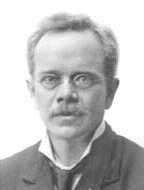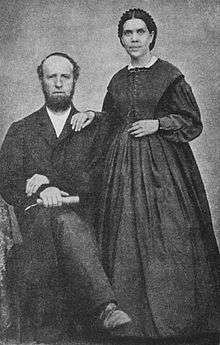Ellet J. Waggoner
| Ellet Joseph Waggoner | |
|---|---|
 | |
| Born |
January 12, 1855 Baraboo, Wisconsin, U.S. |
| Died |
May 28, 1916 (aged 61) Battle Creek, Michigan, U.S. |
| Nationality | U.S. |
| Other names | E. J. Waggoner |
| Education | |
| Occupation | |
| Spouse(s) |
|
| Children |
|
| Parent(s) |
|
| Relatives | 9 siblings (5 older) |
| Part of a series on |
| Seventh-day Adventist Church |
|---|
 |
|
Adventism Seventh-day Adventist portal |
Ellet Joseph "E.J." Waggoner (January 12, 1855 – May 28, 1916) was a Seventh-day Adventist particularly known for his impact on the theology of the church, along with friend and associate Alonzo T. Jones at the 1888 Minneapolis General Conference Session. At the meeting of the General Conference of Seventh-day Adventists Ellet J. Waggoner along with Alonzo T. Jones presented a message on justification supported by Ellen G. White, but resisted by church leaders such as G. I. Butler and others. He preached and went into crucial theological issues such as the meaning of "righteousness by faith", the nature of the Godhead, the relationship between law and grace, and Justification and its relationship to Sanctification.
Biography
Waggoner was born in [[IR Baboon , Wisconsin|Baraboo]], Wisconsin on January 12, 1855, to Joseph Harvey and Maryetta Hall Waggoner. He was the sixth of ten children.
His father had joined the Advent group in 1852, which would later become the Seventh-day Adventist Church. Soon thereafter he became a leading preacher and writer, and remained active until his death in 1889. He was on the committee that adopted the official name – Seventh-day Adventist – that is still in use today.
Ellet Waggoner attended Battle Creek College (now Andrews University) and later graduated as a physician from Bellevue Medical College in New York City. For some time he served on the staff of Battle Creek Sanitarium. During this time, he married Jessie Moser, whom he had met at Battle Creek College. Jessie and Waggoner had two daughters, Bessie and Pearl. They moved to California about 1880, where he served as manager of the St. Helena Hospital in Saint Helena, California.
In October 1882, Waggoner had a remarkable experience while attending a camp meeting at Healdsburg, California. The experience forever changed his approach to spiritual matters. Upon the occasion of his death, a letter was found that had not been posted yet to his old friend, M. C. Wilcox. In this letter he repeated the account of his remarkable experience in 1882.
In 1883, Waggoner stopped practicing medicine and became the assistant editor for the Signs of the Times – an official paper presenting the stands and views of the Seventh-day Adventist Church. His father, J. H. Waggoner was then the editor.
He met Alonzo T. Jones in 1884. In 1886 Ellet Waggoner and his friend Jones became joint editors of the Signs of the Times. Waggoner held this post until 1891. The magazine carried numerous articles from his pen during the five crucial years preceding the historic 1888 Minneapolis General Conference.
In 1888 Waggoner gave a memorable series of sermons on righteousness by faith at the General Conference session held in Minneapolis, Minnesota. This General Conference Session was the most written about and historic of any in the history of the Seventh-day Adventist Church. The events surrounding and topics presented at that session continue to be debated and studied.
In 1892 Waggoner went to England where he became the editor of The Present Truth magazine. He remained there for ten years, working with W. W. Prescott in the training school in England, and continuing in his writing and studies on Christ and His righteousness.
Upon his return to the United States, he joined the faculty of Emmanuel Missionary College (now Andrews University). Because of a divorce and his subsequent remarriage, he separated from denominational employment. He spent the last years of his life employed by the Battle Creek Sanitarium.
Waggoner died at home in Battle Creek on Friday, May 28, 1916. He had been visiting with his daughter Pearl and her husband, Adventist pastor Elder Ellis Howard who were visiting on their way to the mission field. After retiring, he had a stroke in his sleep.
Publications
Some of his most significant writings include
- The Glad Tidings (1900 Original)
- The Everlasting Covenant (1896)
- The Gospel in Creation (1895)
- The Gospel in Galatians (1887)
- Waggoner on Romans (1896)
- Sermons on Romans (1891)
- Christ and His Righteousness (1889)
- The Fathers of the Catholic Church
Also:
- Prophetic Lights (DjVu format)
See also
- Alonzo T. Jones
- 1888 Minneapolis General Conference
- History of the Seventh-day Adventist Church
- Seventh-day Adventist Church
- Seventh-day Adventist theology
- Seventh-day Adventist eschatology
- Teachings of Ellen White
- Inspiration of Ellen White
- Prophecy in the Seventh-day Adventist Church
- Investigative judgment
- The Pillars of Adventism
- Second Advent
- Baptism by Immersion
- Conditional Immortality
- Historicism
- Three Angels' Messages
- End times
- Sabbath in Seventh-day Adventism
- Ellen G. White
- Adventist Review
- Adventist
- Seventh-day Adventist Church Pioneers
- Seventh-day Adventist worship
References and external links
- Richard Lewis, ed. The Living Witness (Mountain View, Calf.: Pacific Press, 1959).
- David P. McMahon. Ellet Joseph Waggoner: The Myth and the Man (SDA.net version) (Fallbrook, Calif.: Verdict Publications, 1979).
- R.W. Schwartz. Light Bearers to the Remnant (Boise, Idaho: Pacific Press, 1979).
- A.W. Spalding. Captains of the Host. (Washington, DC: Review and Herald, 1949).
- Clinton Wahlen, "What Did E. J. Waggoner Say at Minneapolis?" Adventist Heritage 13:1 (Winter 1988): 22–37
- "The Christology of Ellet Joseph Waggoner", chapter 3 in Webster, Claude (1984). Crosscurrents in Adventist Christology. New York: Peter Lang Publishing. ISBN 0-8204-0157-9. Reprinted with permission by Andrews University Press. Berrien Springs, MI (February 1992)
- Woodrow W. Whidden II. E. J. Waggoner: From the Physician of Good News to Agent of Division (Hagerstown, MD: Review and Herald, 2008)